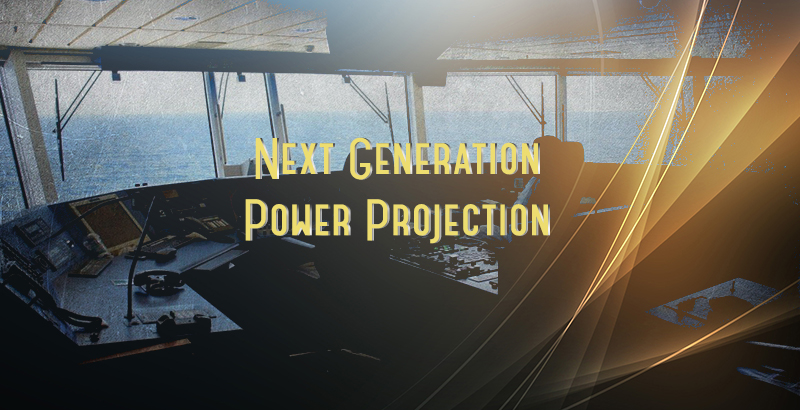
An apparent trend in many navies of the world today is the fielding of multi-purpose vessels along the lines of the traditional LHD platform, but with added capabilities. It appears that in an age of increasingly asymmetrical warfare or limited conflict, both highly modernized and developing navies are acquiring these vessels. These multi-use vessels are being built to provide their nations a power projection capability that is well suited to the likely asymmetrical nature of modern conflict. These vessels can respond quickly to both natural and man-made disasters, providing peace keeping troops, relief supplies, hospital facilities, water purification and helicopter rescue and evacuation. They can also respond quickly to a localized military threat, bringing a significant fighting force to bear in a short interval of time.
In an age of increased state sponsored terrorism these vessels can act as effective offshore command and control stations for anti-terrorism operations. They can accommodate and facilitate the insertion of special operations forces both via air and sea. They can support special operations teams once in the field with air support, up to date reconnaissance, logistical support, and emergency extraction in short duration. In light of the flexibility inherent in these vessels and the power projection capabilities they possess they are a force multiplier in a modern conflict.
Written by Brian Kalman and Igor Pejic exclusively for SouthFront: Analysis & Intelligence.
Brian Kalman is a management professional in the marine transportation industry. He was an officer in the US Navy for eleven years. He currently resides and works in the Caribbean.
Igor Pejic graduated Political Science Foreign Affairs Department at the Faculty of Political Science and now he is a postgraduate student on the MA Terrorism, Security and Organised Crime at the University of Belgrade, Serbia.

The many varied nations of the world that have maritime borders operate navies of equally varied composition and capability. From the imperial monolith of the United States to the small island nation of the Philippines or Taiwan, all such nations must maintain navies to ensure their defense, access to trade, relief in events of natural and manmade disaster and to protect their national interests. Regional powers such as India, China and Japan have different security interests and strategies, and their naval composition and capabilities reflect these realities.
China and India are growing in influence and are accordingly investing in modernizing their navies in order to protect expanding interests and to facilitate power projection capabilities. Russia finds itself in similar circumstances, and has spent decades rebuilding a viable and capable naval arm that more apply reflects its proud naval heritage. Japan has found that it must increasingly rely more on itself to ensure its defense in a region of potential adversaries that possess increasingly more capable navies and ballistic missile forces. The offensive military strategies of both the United States and NATO are fueling the decision of many nations to start new building programs, whether they are allied with these institutions or are their targets. China and Russia are reacting to an ever more obvious strategy to contain and control their national growth.
The past fifteen years has seen the United States and its allies engage in numerous military invasions and interventions in the Middle East. All of these operations have utilized strike aircraft, special operations forces and armed and unarmed UAVs as force multipliers. These force multipliers have allowed for successful prosecution of offensive operations while reducing the conventional military forces required, as well as reduced the duration of operations. The success of such operations in localized, low-intensity conflicts is especially evident. Warships that can provide a platform to transport and support small, combined arms units of strike aircraft, helicopter assault or amphibious assault infantry or marines, special operations units, and reconnaissance and attack UAVs are seen as an essential tool in prosecuting the low intensity conflicts of the future.
It is quite evident with minimal research to find that every nation with a significant naval footprint in the world is investing in new multirole vessels. These vessels come in a number of different forms and can be built to particular specifications. The military operations of the past decade and a half are influencing the naval strategy of many nations with the backdrop of two major geo-political centers of tension: the South China Sea and Syria. Conflict or future conflict in these areas will require the forces engaged to utilize these new and flexible tools of power projection in order to prevail.

There are a number of different designs that fit into the category of the Multirole Naval Platform (MRNP). Some of these designs optimize flexibility and provide a balance of command and control, strike aircraft, air and amphibious assault, or cargo space while others are designed to maximize the effect of only one or two of these capabilities. For example, the Landing Helicopter Dock (LHD) is very flexible, with helicopter and amphibious assault capabilities, ample cargo space and medical facilities for Humanitarian Aid and Disaster Relief (HADR) operations and even accommodation of VSTOL strike aircraft. The Helicopter Dock Destroyer (DDH) is aviation-centric, with no amphibious capability. More space is allotted to aircraft and the fuel and armaments they require. The Landing Platform Dock (LPD) is a smaller version of the LHD in many respects, being under 20,000 tons displacement. These vessels are a good alternative to the LHD when the nation lacks the operational or economic ability to maintain the larger LHD, or the vessels will most likely be operating in shallower or more confined waterways. Greater speed and smaller size (stealth) are also benefits of this design. The Landing Ship Tank (LST) is designed to transport and land a combination of infantry and tanks or other heavy vehicles. They may also possess a small number of aircraft for reconnaissance, support and air assault.

The LHD is the most balanced, and thus flexible of all of the MRNP designs. The LHD is the largest design, requiring the dimensions and space to accommodate a large number of aircraft, troops, light and heavy vehicles, cargo and amphibious assault craft. As a result, the displacement of these vessels is usually between 25,000 and 40,000 tons. A good examples of an LHD are the HMAS Canberra L02, USS Wasp LHD1 and SPS Juan Carlos I L61.
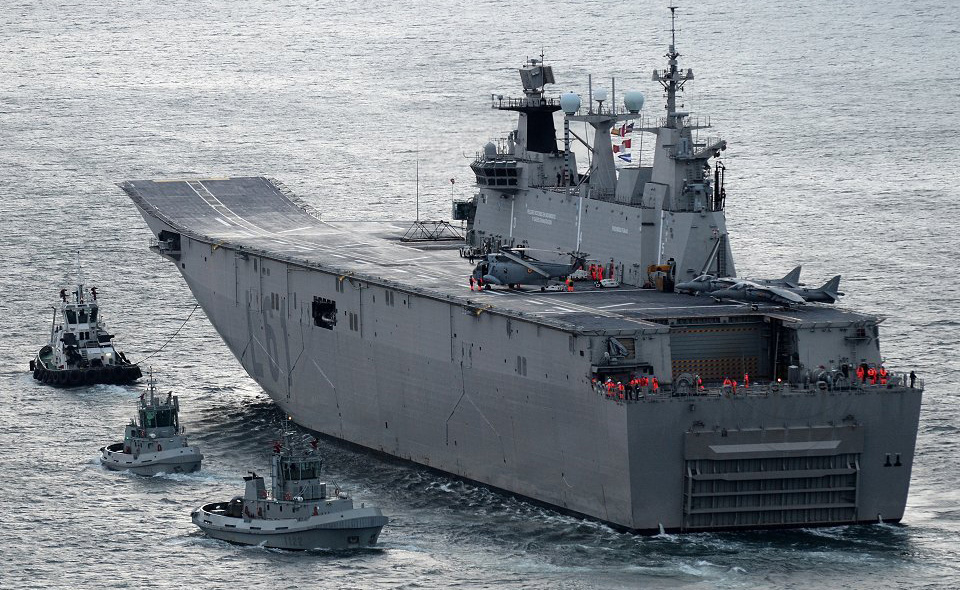
Juan Carlos I LHD
These vessels have to be large enough to accommodate the following features:
- Large flight deck to allow helicopter assault operations and or humanitarian support/evacuation.
- Large internal aircraft hangar deck.
- Heavy/light vehicle deck. Often doubles as a cargo deck.
- Floodable well deck for the launching and recovery of landing craft, LCACS and/or amphibious vehicles.
- Accommodation and facilities for between 500 and 2,000 troops.
- Hospital facilities.

The LPD is a well-balanced multirole vessel; however, on a smaller scale than the LHD. It has comparable flexibility, but at a much smaller scale it lacks the power projection capability of the LHD. It has a small aircraft component, a smaller troop carrying capacity, and less long term self-sustainability. They are designed to provide more amphibious capability than air assault. It is of smaller dimension and displacement than the LHD, coming in at between 8,000 and 20,000 tons. Although their smaller size limits the scope of their operations, they gain the benefit of being able to operate more easily in littoral waters and are less costly to build and maintain. They have a shallower draft and smaller dimensions that lend to them being more suited to more constricted coastal waterways.
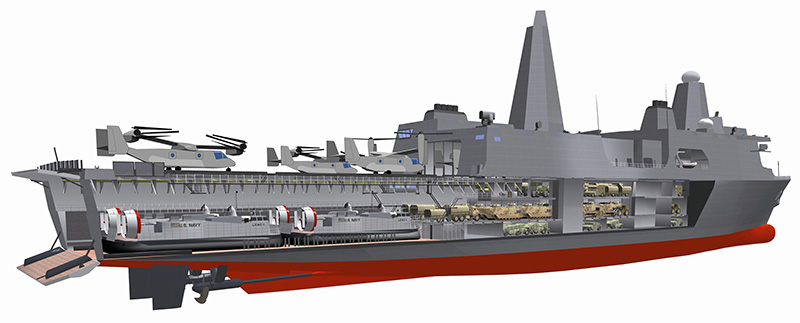
San Antonio Class LPD
The vessels of the LPD pattern possess the following characteristics:
- A flight deck that allows for limited helicopter assault and or humanitarian support/evacuation.
- Small internal hangar deck.
- Heavy/light vehicle deck.
- Floodable Well deck for the launching and recovery of landing craft and LCACs.
- Accommodation and facilities for between 200 and 1,000 troops.
- Hospital facilities.

The DDH is a relatively new adaptation of the MRNP. The DDH abandons all amphibious capabilities in favor of aircraft assault and aerial strike capability. The only two nations to build and operate DDHs are the United States and Japan. The JMSDF operates three DDHs currently, with a fourth vessel to enter operation in 2016. The United States has only one DDH, the USS America with another the USS Tripoli slated to be commissioned in 2018, if construction and sea trials go according to plan. Although the USS America and USS Tripoli are designated LHAs, they lack the amphibious capabilities of all other LHAs before them and should not be categorized as such. The displacement of a DDH ranges between 19,000 and 46,000 tons.
The Japanese DDHs lack a well deck and all space that would be devoted to amphibious equipment is utilized to support helicopter operations. These vessels act as command vessels in the JMSDF Escort Fleet Flotillas, are loaded with ASW helicopters and other ASW countermeasures along with a full complement of helicopter assault troops. The larger Izumo class DDHs have a large enough flight deck and internal hangar space to equip them with fixed-wing VSTOL aircraft, most likely the F-35B, if so decided in the future. The smaller Hyuga class DDHs have both been used in HADR operations over the past few years in response to an earthquake and a major hurricane, where their helicopter support and evacuation capability proved of benefit.

Rendering of America Class LHA equipped with F-35B VSTOL strike aircraft
The notable characteristics of the DDH are as follows:
- Very large flight deck that can accommodate medium and heavy helicopters and VSTOL strike aircraft and UAVs.
- Large internal hangar decks to service aircraft.
- Accommodation and facilities for between 300 and 1700 troops.
- Hospital facilities.
The USS America LHA6 has proven to be a controversial topic amongst the US Navy and Marine Corps. Many see the vessel as a small aircraft carrier and do not see the need for such a vessel for the USMC. The USMC’s traditional role as an amphibious force should not be abandoned, and the flexibility exhibited by the force of LHAs and LPDs already operated by the force offer far more flexibility to USMC expeditionary forces than the America Class vessels. Why remove a tool from your toolbox? The USMC has traditionally relied on the US Navy to provide aerial strike capability when so required, and the US Navy has ten aircraft carrier strike groups in service. It has largely been accepted that the USS Tripoli LHA7 will be the last vessel in this class to lack a well deck, with all other vessels in class being redesigned to allow for amphibious operations.

While traditionally designed to be beached bow-first to discharge tanks and heavy combat vehicles, the LST design has matured to allow for discharge via bow ramp or well deck like the LHA and LPD. Although not really an MRNP due to the limits in its capabilities, more modern LSTs share more in common with the LPD or LHD than in the past. The Navy of the Republic of Korea operates 4 modern LSTs with bow ramps of the Go Jun Bong class, and is currently in the second phase of LST development (LST-II), having designed more capable ships. These vessels usually carry a mixture of tanks, AAVs, and small landing craft as well as support vehicles along with 200 to 300 marines. These vessels lack helicopter assault capability, with only a small helicopter deck fitted.
The JMSDF operates three LSTs; however, their design is more akin to an LPD or LHD, having a stern well deck that houses two LCACs for transporting tanks (up to 10 Type 10 MBTs), vehicles and troops ashore. The Osumi class vessels also can carry up to eight helicopters for transporting troops or for support and evacuation in HADR operations. Funds have recently been allocated to study the feasibility of refitting these vessels with V-22 Osprey tilt-rotor aircraft and AAV7s for amphibious assault.

ROK Navy Seong In Bong LST685 discharging a K1 MBT
The LST is usually close in size and displacement to the LPD, though slightly smaller. The bow-ramp LST has a very shallow draft in comparison to its size, due to the requirement to beach the vessel bow-first in order to discharge vehicles. Displacement ranges between 4,000 and 14,000 tons. The characteristics of the LST include:
- A large bow ramp for discharging tanks, vehicles and troops while beached or a well deck for launching amphibious forces and tanks via LCAC or landing craft.
- Limited aircraft capability.
- Ability to carry approximately 10 to 12 MBTs and other vehicles.
- Accommodation and facilities for between 250 and 1,000 troops.
- Limited hospital facilities.

It is obvious to see the benefits of the MRNP with their inherent flexibility, humanitarian support and power projection capabilities. Such vessels would be of benefit to any nation with an extensive maritime border. The benefits are obvious, but why are so many vessels now being built in such a short span of time? These naval building programs are being driven by geo-political developments in two main regions of the globe, the Mediterranean and the Asia-Pacific. This is in direct relation to the wars of regime-change and disruption in the Middle East and the U.S. “Pivot to Asia” and the disputes over contested areas in the East and South China Seas.
When identifying the driving cause, a common denominator is the hegemonic foreign policy of the United States. The wars of regime change that wrought chaos in Iraq, Libya, Egypt and now Yemen and Syria were all spearheaded by the United States and NATO. The result of these operations has been failed states and humanitarian catastrophe for those nations targeted. Syria has been laid waste by a Wahhabist invasion that was created by Saudi Arabia and their emirate allies in conjunction with the United States. The threat of direct military intervention in Syria by the United States in 2014, turned the Mediterranean into the largest possible naval battle ground in recent times.
Nations building/acquiring MRNPs in the Europe/Mediterranean:
France: 3
- 3 x Mistral Class LHDs built between 2004 and 2012.
Spain: 3
- 1 x Juan Carlos I Class LHD, 2 x Galicia Class LPDs built by Navantia recently acquired (2010 to present).
Russia: 2 (planned)
- 2 x Mistral Class LHDs built by France and sold to Egypt. Sold to Egypt in 2015. Now seeking 2 x LHDs of indigenous design and manufacture.
Turkey: 1
- Building 1 x LPD based on Juan Carlos I Class of Spanish shipbuilder Navantia starting 2015.
Egypt: 2
- Recent purchase of 2 x Mistral Class LHDs from France in 2015.
In East and Southeast Asia the reality of a resurgent China, a nation that can trace its civilization back for over five thousand years, has been met with open hostility on the part of the United States. Apparently, the U.S. government believes that China should be allowed to expand its economic power, but not its military ability or geo-political influence. In an attempt to hamper Chinese expansion in these areas, the United States has decided to aid China’s potential adversaries at every turn. Nations such as Vietnam and the Philippines, wary of any Chinese expansion in the South China Sea and with equal claims to islands and oils and gas fields there, have been on the receiving end of U.S. support and even military assistance.
Nations in Asia building/acquiring MRSVs:
India: 1 (of 4)
- Acquired 1 x Austin Class LPD from the U.S. in 2007. Plan to acquire a total of 4 x LPDs of a new design by 2020.
China: 4 (of 12)
- 4 x Type 071 Class LPD built between 2007 and 2015, with 2 more being constructed. Plans to build 6 x LHDs have been in the works since 2005.
Japan: 7
- 2 x Hyuga Class DDH and 2 x Izumi Class DDH built between 2006 and the present. 3 x Osumi Class LST built between 1998 and 2003.
South Korea: 1 (of 2)
- 2 x Dokdo Class Landing Platform Helicopter (LPH) built between 2007 and the present. The second in class planned to handle VSTOL strike aircraft. A newer LPX design is also in the planning stage.
Indonesia: 4
- 4 x Makassar Class LPD built between 2007 and 2011.
Philippines: 2 (of 4?)
- 2 x LPD being built on the Makassar Class pattern in Indonesia. Delivery planned between 2016 and 2017. The Philippine Navy may decide on a total complement of 4 such vessels.
United States: 30 (of 34)
- This includes 9 x San Antonio Class LPDs built of a planned 12 total vessels between 2006 and the present, as well as 1 x America Class LHA built of a planned 2 total vessels between 2015 and the present.
(It is important to note that the United States is building more new MRNPs than any other nation in this analysis by a wide margin. These new vessels will be added to the older class of LHDs and LSDs that were built and commissioned between 1985 and 2002.)

There are a number of territorial disputes in the South China Sea between China and a number of other nations. These disputes are ostensibly matters of exerting sovereignty over historical territories; however, the likely presence of oil and natural gas and highly prized fishing rights are of far greater importance. The same issues are at the root of the dispute between China and Japan over the Senkaku (Diaoyu) Islands.
The war in Syria that has claimed over 250,000 lives and devastated arguably the last secular nation in the Middle East, is another volatile geo-political flash point that has absorbed the efforts of most nations in the Middle East, Russia, the United States and many NATO member states. This is also a conflict centered determining what nations control the flow of oil and natural gas, in this case from the Middle East into Europe, as well as cornering that market as a whole.
The current conflict in Yemen started out as an internal one until Saudi Arabia decided to intervene on the side of the deposed Hadi administration. The Saudis refuse to allow a non-Sunni power friendly to Iran to exist in the region, especially one located on their rebellious southern border region. This conflict has continued to escalate, with numerous allies to Saudi Arabia engaging in airstrikes and naval shelling of the Houthi controlled areas of the country.
The Senkaku Islands
The sovereignty of the Senkaku Islands, known as the Daioyu Islands in China, has been in dispute for centuries. China claims that the islands were their territory centuries before they were illegally annexed by Japan at the conclusion of the Sino-Japanese War of 1894. Japan asserts that the islands were ceded to Japan as part of the ceding of Taiwan “in perpetuity” at the conclusion of the war. Japan surrendered Taiwan to the Chinese Nationalists at the conclusion of World War II, who ended up retreating to the Island at the end of the Chinese Civil War and establishing the Republic of China.
The Senkaku Islands remained in limbo as far as their ownership was concerned, until the government of Japan reasserted sovereignty when they purchased three of the islands from a private Japanese citizen in 2012, effectively legally nationalizing them. China responded by creating a new air-defense identification zone over the islands the following year. Japan upped the ante by forming the Amphibious Preparatory Unit (APU) of 700 men (to be expanded to 3,000), a force of marines that could be dispatched by air or sea to respond to any attempts to occupy the islands. The two nations have sent military aircraft over the islands, and Chinese civilian and auxiliary/research vessels have spared with Japanese Coast Guard vessels in the islands’ waters. China sent an armed vessel to the waters of the Senkakus for the first time in late December of 2015, resulting in a formal diplomatic complaint from Japan.
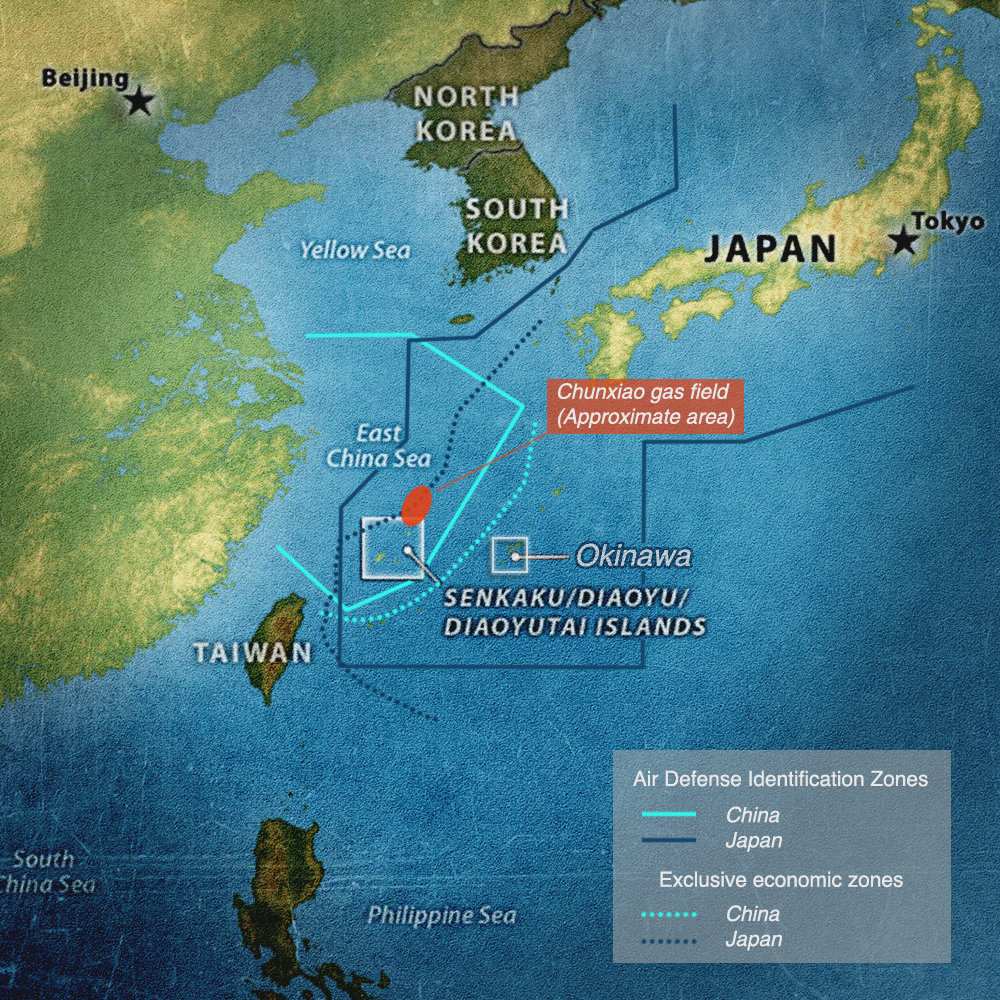
Senkaku Islands detail
It is easy to see how Japan’s new DDHs and LSTs could be utilized in responding to further moves by the Chinese to exert their sovereignty over the Senkaku Islands. The new APU could be deployed to the islands in short order aboard either an Osumi class LST or Hyuga or Izumo class DDH acting as part of one of four Escort Fleet Flotillas. The large DDHs could be equipped with VSTOL F-35B in such a theoretical future conflict over the islands. China would likely use any number of the six Type 071 LPDs in a fleet of escorting warships to occupy the islands and force the issue. It is; however, unlikely that China would attempt to settle the issue militarily before the larger LHDs it has planned for the PLAN come into service in 2020.
South China Sea Disputes
A detailed explanation of the many interlaced territorial disputes in the South China Sea by all the nations involved is beyond the scope of this analysis. There are two main areas of contention: the sovereignty of the entire South China Sea and its legal status as an international waterway for purposes of uninhibited trade, and the sovereignty of particular island chains and shoals. It is theorized that a great deal of oil and natural gas are in abundance under the seabed in many of these disputed areas. Oil and gas exploration and drilling has been underway for a number of years now, most notably in waters south of Vietnam/north of Malaysia and in waters north of Brunei. In pressing its claims of sovereignty China went as far as anchoring an oil exploration rig within the EEZ of Vietnam in May of 2014. Vietnam has a conflicting claim to much of the South China Sea, including the Spratley and Paracel Islands. Malaysia, Brunei, and the Philippines also have disputed claims in the area .China has taken the unprecedented decision to construct man-made islands at three locations in the Spratly Islands as well as construction in the Paracel Islands and Scarborough Shoal.
China most likely started dredging and land reclamation on the first of three man-made islands in the Spratleys sometime in 2011 or 2012. Construction efforts have steadily picked up pace since 2014 and the small reefs and atolls have morphed into artificial islands of thousands of acres in size. China has been building airstrips and port facilities on Fiery Cross Reef, and both Subi and Mischief Reef are undergoing major reclamation. In addition, China is building a fuel depot on Woody Island in the Paracels. China has fought naval skirmishes with Vietnam over control of the Paracel Islands on two separate occasions, one in 1974 and another in 1988. China has also constructed military outposts in Scarborough Shoal which is also claimed by the Philippines, the islands clearly located within that nations EEZ.
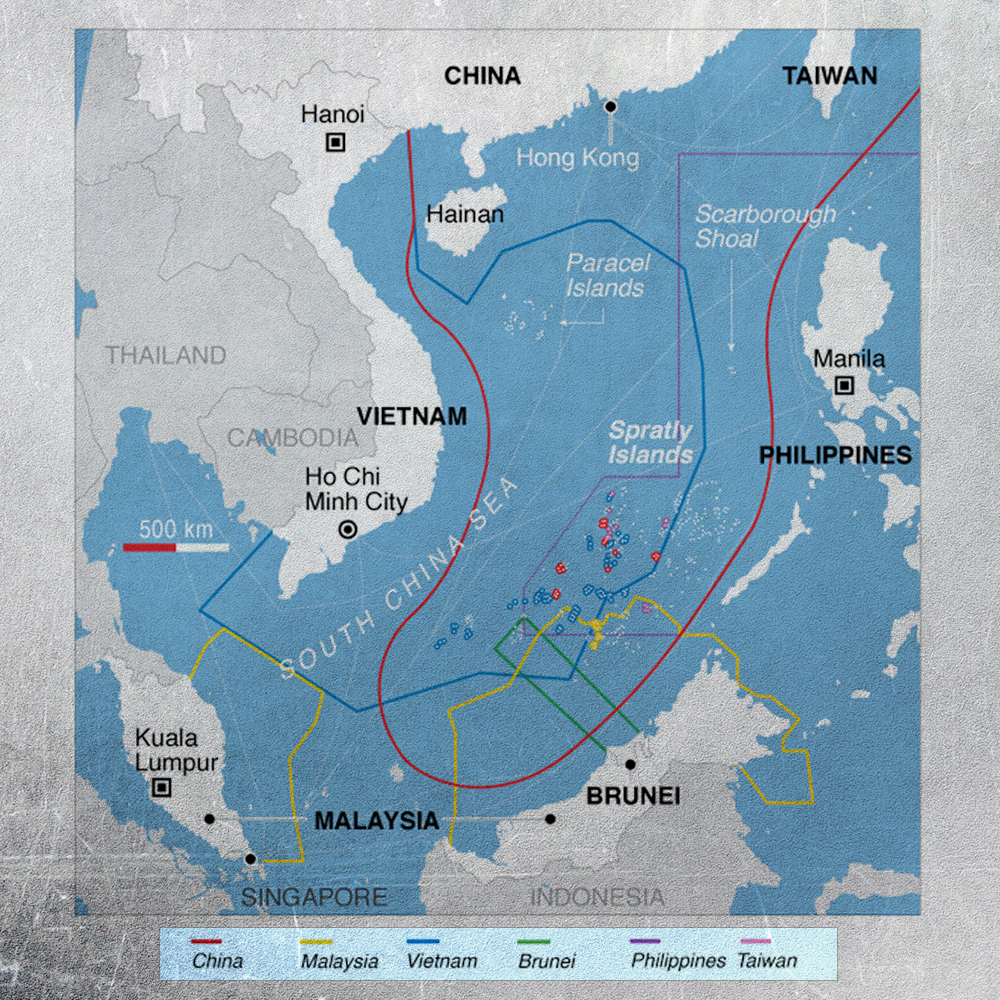
South China Sea conflicting claims
China submitted a formal claim to the United Nations to virtually the entire South China Sea in 2009, which was rejected by that body as it does not comply with established international law governing the establishment of territorial waters. All nations with conflicting claims protested, along with the United States and Indonesia who hold no claims. The building of artificial islands is obviously either an attempt by China to press their claim by occupying and utilizing these islands, or to militarily exert control over the South China Sea as their long term goal. In order to protect these holdings and to react to any threat from prospective adversaries, a navy equipped with LPDs and LHAs is essential. China undoubtedly had this in mind when it started building six LPDs of the Type071 class and designing the new LHAs. The new LHAs are comparable to the Canberra or Mistral class, but are said to be much larger in size, with a displacement approaching 40,000 tons.
The Philippine Navy has received military aid from both Australia and the United States in the face of greater Chinese resolve to solidify their claims. Australia has donated two fully refurbished Balikpapan Class heavy landing craft (LHC) to the Philippine Navy while the U.S. has announced plans to donate two vessels, a decommissioned USCG cutter and a research vessel. Two LPDs based on the Indonesian PT PAL built Makassar are already under construction and should be delivered between 2016 and 2017.
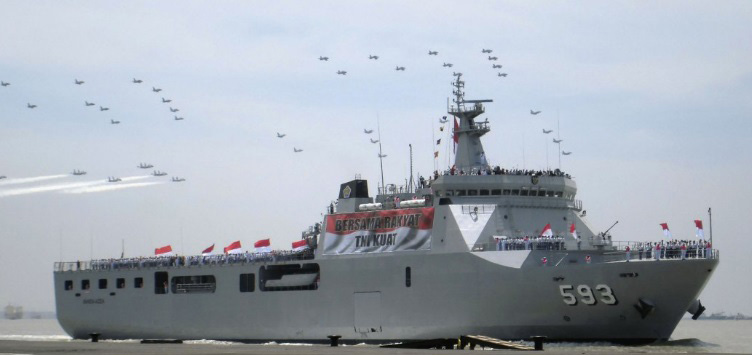
Makassar Class LPD Banda Aceh LPD593.
It is easy to imagine a future conflict in the South China Sea where all major parties to the conflict will benefit from utilizing newly acquired MRNPs. Vessels that can land marines or assault troops via landing craft or AAVs complete with armored support, combined with air assault elements and that can provide aircraft to provide ground attack and air superiority cover to the attack force are a tool that both China and those aligned with the United States in this dispute have decided they must have. Any asymmetrical warfare that might take place could be commanded and coordinated from LHAs or LPDs. Special forces can operate from these platforms with insertion and extraction by sea or air, with reconnaissance support from the advanced sensors and information systems onboard as well as from UAVs launched and recovered from their flight decks. If a military confrontation happens, whether a result of miscalculation or by design, these new vessels will likely play a large part. As the United States ratchets up pressure in continuous “freedom of navigation” missions with armed warships and strategic bomber forces, the Chinese will be forced to either respond in kind or back down. Hopefully, statesmanship and compromise will prevail.
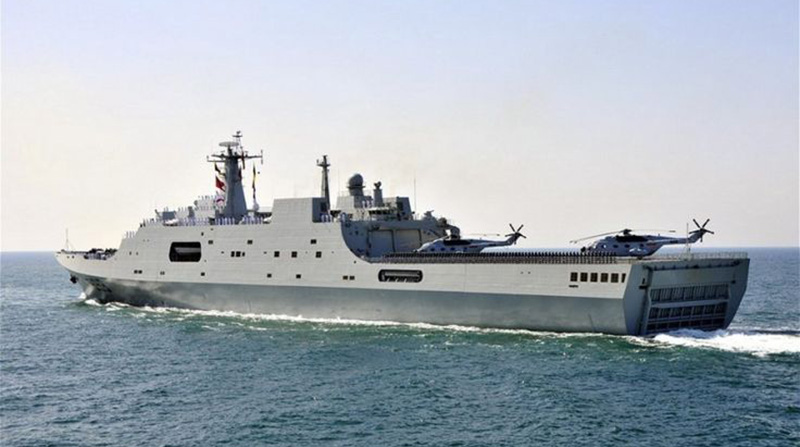
Chinese Type 071 LPD underway
The War in Syria
The war that has raged in Syria for 5 years now has taken a decisive turn since Russia started its air campaign to aid the Syrian Arab Army in its fight to regain the initiative in the war and destroy the mostly foreign Wahhabist elements fighting the state on behalf of foreign interests. Russia is undoubtedly aiding a longtime ally in a time of desperate need, as well as ensuring its own defense in the long run. Russia has been fighting equally unsavory and illegitimate Wahhabist forces in its own Caucasus republics, and it is reasonable to believe that those forces fighting in Syria, if victorious would turn their sights north toward Russia. They would find willing allies in Turkey, Saudi Arabia, Qatar and the UAE (all of which are funding and aiding the various terrorist groups fighting against the Syrian state) and Russia cannot allow this to come to pass.
A very defined delineation of adversaries has begun to emerge in this conflict in the form of three distinct blocks. One side is made up of those forces that aim to reestablish the legitimate sovereign state of Syria. They also aim to establish a mutually beneficial logistical route of oil and natural gas transport through their nations to the European market. These nations are Syria, Iraq, Iran and Russia. Russia, most importantly seeks to maintain balance.
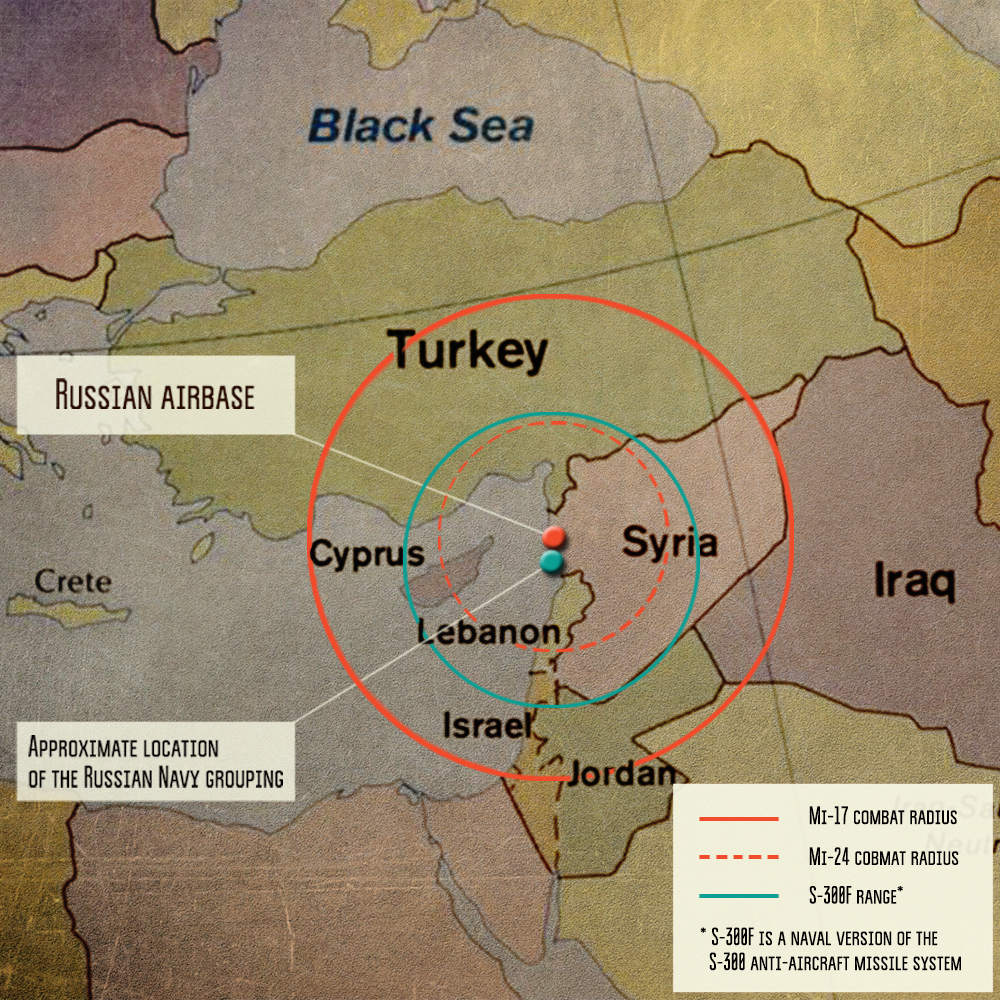
On another side there are the nations that aim to overthrow the government of Syria and render the nation impotent and malleable to their wishes. They hope to be able to control the groups that they have armed and funded to overthrow the legitimate government in Syria, so that after the war they can leverage beneficial oil and natural gas transit contracts that will allow them to control the transport of oil and natural gas from the Middle East to Europe, while cutting out Iran and Iraq, and undercutting Russian prices. These nations are Saudi Arabia, Turkey, Qatar, Bahrain and the United Arab Emirates.
The third side is comprised of nations that hope to continue the destabilization of the entire region to the detriment of Russia and Iran. They would rather see the Saudi alliance gain control of oil and natural gas transit to Europe than the Syria-Iraq-Iran alliance. This forces Russia and Iran to invest resources into fighting regional conflicts, while they continue to militarily surround them and fund internal forces to destabilize them. This side is composed of the United States and NATO.
The Case of the Russian Mistrals
Although the much hyped reason that France reneged on the contract to deliver two Mistral Class LHDs, the Vladivostok and the Sevastopol, to Russia was the Russian “invasion” of the Ukraine and the “annexation” of the Crimea. Although the invasion and annexation were the fantasy creation of a concerted western media and White House propaganda campaign, they were just a convenient cover for the real reason that the Mistrals could not be delivered to Russia. The true reason was a very possible, and by September of 2015, real Russian intervention in Syria.
The United States and NATO, at times in coordination with the Saudi Arabia/Gulf emirate alliance, had been deeply invested in the overthrow of the Syrian government since the start of conflict in 2011. Turkey, also a member of NATO, is deeply involved in the conflict for a number of reasons, and due to its geographical location stands the most to lose from a Russian intervention. It became apparent when Russia responded to a very possible direct military intervention by the United States and NATO in 2013 by moving a large number of warships into the Mediterranean, that it wasn’t just the U.S. that had a red line that could not be crossed. Russia was ready for war, but fortunately Russia was able to broker a deal to exchange Syrian chemical weapons for de-escalation. The U.S. administration should have understood at this juncture that Russia would not allow the Syrian government to be overthrown by an unlawful military campaign. If Russia was to intervene as a collapse of the Syrian government seemed likely, the addition of two Mistral Class LHDs to their naval assets could not be tolerated.
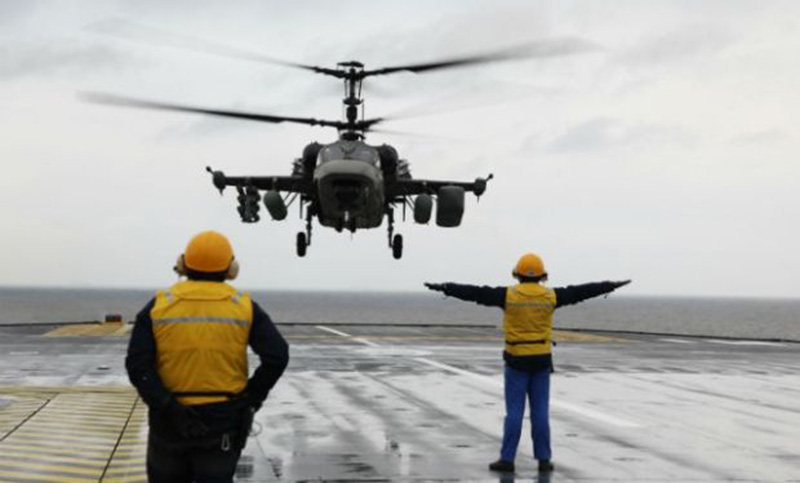
Naval variant Ka-52 Alligator landing on Mistral Class LHD during trials
It is arguable that at least one of the Mistrals, the Vladivostok would be available to take part in Russia’s current operations in Syria. The crew had been training for over a year in preparation for its commissioning in 2014. This vessel would have been a great asset positioned off the Syrian coast, being able to respond to support the airbase in Lattakia or to deliver ground attack support and troop transportation along the entire Syrian coast. It could act as a powerful joint naval/land force command ship and could support aerial operations with a force of reconnaissance UAVs. If need be, Russian marines and Spetsnaz could also deploy from this floating base of operations. It would have been a force multiplier in the region, and would definitely have influenced any calculus on the part of Turkey. It could also have been position in the Black Sea or close to the Bosporus to influence the decision making of the Erdogan regime or to react to any Turkish provocations.
Russia is determined to acquire LHDs or LPDs for the Russian Navy. It has announced with the cancellation of the Mistral deal that it will be asking indigenous ship builders to provide the government with designs for a similar platform to meet the needs of the Ministry of Defense (MoD). It is interesting to note that Turkey signed a contract in May of 2015 with Navantia of Spain to build an LPD based on the Juan Carlos I LHD design. This is the same design that was used as the basis of the Royal Australian Navies newly commissioned HMAS Canberra and soon to be commissioned HMAS Adelaide. Apparently, Turkey will be receiving one of these modern power projection vessels before Russia does. Russia lost a valuable head start when they decided to trust France to honor a basic contract. Apparently two centuries of peaceful relations between the two nations after the defeat of Napoleon mean little to the French leadership of today.
The Yemen Conflict and the Indian Ocean
It appeared, with the overthrow of an illegitimate ruler who gained office in an election where there was only one candidate that Yemen was moving towards stability, after a period of civil war and terrorism. Not long after the forces of the Houthi and Saleh aligned factions forced the Saudi aligned Abd Radduh Mansur Hadi to flee the country in February of 2015, the Saudi Arabian Airforce started bombing the impoverished country. It was clear that Saudi Arabia would not tolerate a predominantly Shia Houthi movement that shares good relations with Iran to take control of the nation that is on their disputed southern border. A coalition of nations under the leadership of Saudi Arabia has since been formed partly due to Saudi inability to prevail militarily and partly to add an air of legitimacy to the illegal Saudi invasion. The Houthis have been able to hold roughly a third of the country, with the other two thirds are controlled by the Hadi government and Ansar-al Sharia and Al Qaeda in the Arabian Peninsula (AQAP). It is interesting to note that the Saudi-proxy terrorist groups have flourished in Yemen since Saudi Arabia started their campaign.
It was announced in September of 2015, that the two Mistral Class LHDs that were denied to Russia were purchased by Egypt. Egypt is a member of the Arab League sanctioned coalition that is engaged in the conflict in Yemen and currently has air and naval assets engaged. It remains to be seen if the conflict will see the use of the two LHDs at some future date. With the Saudi led coalition making little headway in the conflict, even with the aid of terrorist bombings by their allies in Ansar al-Sharia and AQAP, there may be time remaining to the Egyptian Navy to take delivery of the vessels, train the vessel crew and Ka-52 air crews and add these powerful vessels to the naval assets already engaged in the conflict.
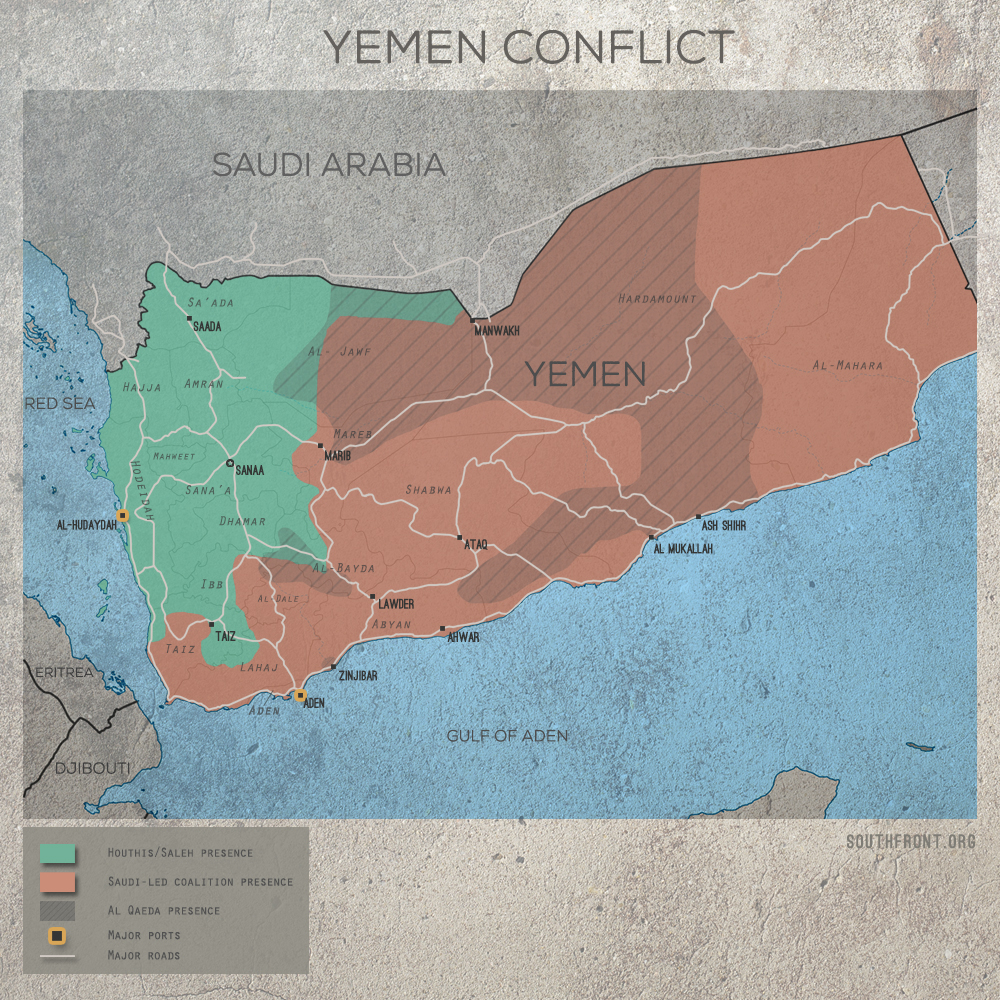
It is important to note that the entire Indian Ocean is growing in strategic importance in light of developments over the past three decades. India is positioned between a volatile Arabian Peninsula and Horn of Africa to the west and a traditional enemy in Pakistan and an ever increasingly assertive China to the east. India has wisely responded by modernizing its aircraft carrier force with the acquisition of a Soviet Era Kiev Class aircraft carrier, which was heavily modified and commissioned into the Indian Navy as the INS Vikramaditya in 2013. The INS Viraat, a former British Centaur Class aircraft carrier HMS Hermes, is also in service, but is slated to be replaced by the indigenously designed and built INS Vikrant by 2018. INS Vikrant will commence sea trials this coming year. The Indian Navy has called for proposals for its Multirole Support Vessel (MRSV) project, and has specified an LHD design of between 20,000 and 27,000 ton displacement. It appears that Navantia is the leading contender to win the contract; however the DCNS designed Mistral 140 concept, at a much smaller displacement of 14,000 tons may be a contender.

The world is currently faced with a number of regional conflicts that could easily and regrettably become conflicts of global proportion. Nations as small and as economically limited as the Philippines to the military juggernaut that is the United States, have moved in recent years to acquire vessels that allow them flexibility, power projection capability, and asymmetrical warfare options in an ever increasingly complex geo-political landscape. From the Middle East to East and Southeast Asia to the Indian Ocean, the world is challenged by conflicts that defy international law regardless of the claims of the perpetrators. All of these conflicts have been decades in the making.
As the nations on every side of these conflicts plan their strategy, both diplomatically and militarily, one fact stands out loud and clear. They have all either acquired or are in the process of acquiring multirole naval platforms such as the LHD,LPD,LHA or DDH to empower their navies and to provide more options to diplomats, military planners and warfighters to stay one step ahead in an ever changing geo-political landscape. These vessels are not game-changers on their own, but when employed as a component of a modern naval force, they provide an added power projection capability and a host of options to naval strategic planners. They are a force multiplier in 21st century naval warfare.
It remains to be seen how the current conflicts and disputes will be resolved by all of the assorted stakeholders. The fact that these vessels are being added to the naval inventories of many of the real or potential belligerents of these conflicts and disputes carries the probability that they will be used in the future. All we can do is hope that their inherent power and capabilities will work as a deterrent to conflict and war, and that they will one day be looked on in awe as a tool ultimately left sheathed, while intimidatingly ensuring peace.





